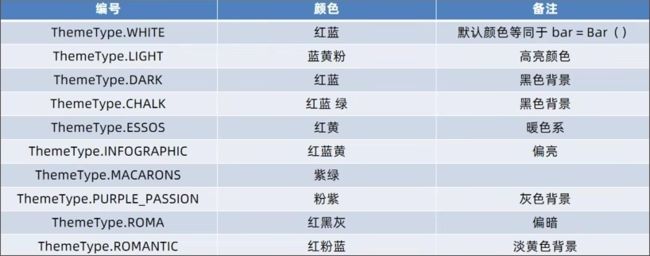第十二章、Python基础综合案例(数据可视化-动态柱状图)
基础柱状图
1.通过Bar()构建一个柱状图对象
2.和折线图一样,通过add_xaxis()和add_yaxis()添加x和y轴数据
3.通过柱状图对象的:reversal axis(),反转x和y轴
4.通过label_opts=LabelOpts(position="right")设置数值标签在右侧显示
"""
基础柱状图的开发
"""
from pyecharts.charts import Bar
from pyecharts.options import LabelOpts
import os
# 使用Bar构建基础柱状图
bar = Bar()
# 添加x轴的数据
bar.add_xaxis(["中国","美国","英国"])
# 添加y轴数据
bar.add_yaxis("GDP",[30, 20, 10],label_opts=LabelOpts(position="right"))
# 反转x和y轴
bar.reversal_axis()
# 绘图
bar.render("基础柱状图.html")
os.system("基础柱状图.html") 基础时间线柱状图
什么是时间线?
from pyecharts.charts import Timeline
timeline = Timeline()
自动播放
# 自动播放设置
timeline.add_schema(
play_interval=1000, # 自动播放的时间间隔,单位毫秒
is_timeline_show=True, # 是否在自动播放的时候,显示时间线
is_auto_play=True, # 是否自动播放
#is_loop_play=True # 是否循环播放(默认开启循环)
)
如何设置主题
timeline = Timeline({"theme":ThemeType.__主题__})
"""
带有时间线的柱状图开发
"""
from pyecharts.charts import Bar,Timeline
from pyecharts.options import LabelOpts
from pyecharts.globals import ThemeType
import os
bar1 = Bar()
bar1.add_xaxis(["中国","美国","英国"])
bar1.add_yaxis("GDP",[30, 30, 20],label_opts=LabelOpts(position="right"))
bar1.reversal_axis()
bar2 = Bar()
bar2.add_xaxis(["中国","美国","英国"])
bar2.add_yaxis("GDP",[50, 50, 50],label_opts=LabelOpts(position="right"))
bar2.reversal_axis()
bar3 = Bar()
bar3.add_xaxis(["中国","美国","英国"])
bar3.add_yaxis("GDP",[70, 10, 30],label_opts=LabelOpts(position="right"))
bar3.reversal_axis()
# 构建时间线对象
timeline = Timeline({"theme":ThemeType.PURPLE_PASSION})
# 在时间线内添加柱状图对象
timeline.add(bar1,"点1")
timeline.add(bar2,"点2")
timeline.add(bar3,"点3")
# 自动播放设置
timeline.add_schema(
play_interval=1000, # 自动播放的时间间隔,单位毫秒
is_timeline_show=True, # 是否在自动播放的时候,显示时间线
is_auto_play=True, # 是否自动播放
#is_loop_play=True # 是否循环播放(默认开启循环)
)
# 绘图是用时间线对象绘图,而不是bar对象了
timeline.render("基础时间线柱状图.html")
os.system("基础时间线柱状图.html")GDP动态柱状图绘制
"""
动态GDP柱状图绘制
"""
from pyecharts.charts import Bar,Timeline
from pyecharts.options import *
from pyecharts.globals import ThemeType
import os
# 读取数据
f = open("D:/BaiduNetdiskDownload/资料/可视化案例数据/动态柱状图数据/1960-2019全球GDP数据.csv","r",encoding="GB2312")
data_lines = f.readlines()
f.close()
# 删除第一条数据
data_lines.pop(0)
# 将数据转换为字符串,格式为:
# { 年份: [ [国家, gdp], [国家, gdp],....... ], 年份:[ [国家, gdp], [国家, gdp], ......], ......}
data_dict = {}
for line in data_lines:
year = int(line.split(",")[0])
country = line.split(",")[1]
gdp = float(line.split(",")[2])
# 判断字典内有无指定的key
try:
data_dict[year].append([country, gdp])
except KeyError:
data_dict[year] = []
data_dict[year].append([country, gdp])
# 创建时间对象
timeline = Timeline({"theme": ThemeType.INFOGRAPHIC})
# 排序年份
sort_year_list = sorted(data_dict.keys())
for year in sort_year_list:
data_dict[year].sort(key=lambda element:element[1],reverse=True)
#
data_dict[year] = data_dict[year][0:8]
x_data = []
y_data = []
for county_gdp in y_data:
x_data.append(county_gdp[0]) # x轴添加国家
y_data.append(county_gdp[1] / 100000000) # y轴添加gdp
# 构建柱状图
bar = Bar()
x_data.reverse()
y_data.reverse()
bar.add_xaxis(x_data)
bar.add_yaxis("GDP亿",y_data, label_opts=LabelOpts(position="right"))
# 反转x轴和y轴
bar.reversal_axis()
# 设置每一年图表的标题
bar.set_global_opts(
title_opts=TitleOpts(title=f"{year}年全球前八GDP数据")
)
timeline.add(bar, str(year))
# for循环中每一年的数据,基于每一年的数据,创建每一年的bar对象
# 在for中,将每一年的bar对象添加到时间线中
timeline.add_schema(
play_interval=1000,
is_timeline_show=True,
is_auto_play=True,
is_loop_play=False
)
# 绘图
timeline.render("GDP动态柱状图开发.html")
os.system("GDP动态柱状图开发.html")